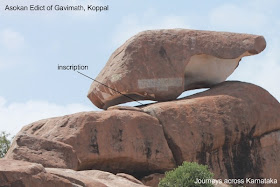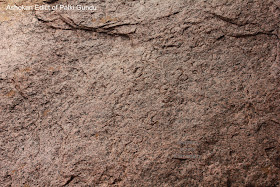Contents of this post are extracted from South Indian Epigraphy notes belonging to a friend Shilpa Vernekar. These were notes jotted down in S.B. Hiremath Sir’s classes conducted in 2004 & 2005 at Kannada Research Institute, Karnatak University, Dharwad. The transcription and translation featured in this post are available in Epigraphia Carnatica.
Introduction
Introduction
https://karnatakatravel.blogspot.com/2012/09/notes-on-koppal-inscriptions.html?m=1
Koppal town is capital of Koppal district in Karnataka state. Earlier Koppal was in Raichur district and it was a Nizam state. In ancient times, Koppal was known as Kopaṇā Mahātirtha or Kopaṇā Drāndra. Kavirajamarga mentions this place by fixing the boundary of Karnataka from Kaveri to Godavari. He fixes original/pure Kannada speaking areas in Kopana, Puligere and Kisuvolal.
In the eastern side of the town is Gavimath, behind this is a hill range. It’s in a cave. Besides it, there are 3 natural caves. The present inscription is in the 4th cave's rock bed. Its’ a natural cave.
It is a 18' x 20'. It’s written in 8 lines. Since Ashokan inscription is found here, In that period it must have been a Buddhist center. Later it was occupied by the Jainas. There are plenty of Jaina Samadhis found in the rock beds. Their sculptures are carved [Kayat Saska or Pratimayoga] i.e. standing or cross legged posture and inscriptions are written below. Even kings and queens sculptures are found as even they took Samadhis. They are called Niṣidhi stones. There are 110 Niṣidhi stones in Sharavanabelagola; nearly 40 in Koppal. Inside the fort, broken inscriptions were found. After Jainas, came the Lingayats.
Koppal inscription was discovered in 1931 by the head of Lingayat Math. He informed N B Shastri of Koppal because he was trying to know the history of the place. Since it was in Nizam state, Shastri sent a message to Hyderabad saying that there are inscriptions in Tamil writing. The office took action and sent Syed Yusuf, Assistant Director. He took estampage after surveying and found that it was Ashokan inscription. Later the director Yazdhani surveyed and confirmed that it was Ashokan.
They are the minor rock edicts in Karnataka. Whereas in Brahmagiri, Jating Rameshwar, Siddapur, the inscription is in two parts and is engraved on the same rock, in Nittur and Uddengolla the two parts are engraved on two rocks. Gavimath and Maski are nearby.
Purpose of the Inscriptions
Koppal town is capital of Koppal district in Karnataka state. Earlier Koppal was in Raichur district and it was a Nizam state. In ancient times, Koppal was known as Kopaṇā Mahātirtha or Kopaṇā Drāndra. Kavirajamarga mentions this place by fixing the boundary of Karnataka from Kaveri to Godavari. He fixes original/pure Kannada speaking areas in Kopana, Puligere and Kisuvolal.
- Puligere is modern Lakshmeswara
- Kisuvolal is modern Pattadkal
- Okkunda is modern Bailhongal
In the eastern side of the town is Gavimath, behind this is a hill range. It’s in a cave. Besides it, there are 3 natural caves. The present inscription is in the 4th cave's rock bed. Its’ a natural cave.
Koppal inscription was discovered in 1931 by the head of Lingayat Math. He informed N B Shastri of Koppal because he was trying to know the history of the place. Since it was in Nizam state, Shastri sent a message to Hyderabad saying that there are inscriptions in Tamil writing. The office took action and sent Syed Yusuf, Assistant Director. He took estampage after surveying and found that it was Ashokan inscription. Later the director Yazdhani surveyed and confirmed that it was Ashokan.
They are the minor rock edicts in Karnataka. Whereas in Brahmagiri, Jating Rameshwar, Siddapur, the inscription is in two parts and is engraved on the same rock, in Nittur and Uddengolla the two parts are engraved on two rocks. Gavimath and Maski are nearby.
Purpose of the Inscriptions
These inscriptions were not intended to record historical facts or to glorify Emperor Ashoka, nor to give a record of his achievements as an emperor. Ashoka’s main aim in these inscriptions was to appeal to the people of his empire and the future generations. His appeal was to follow the great moral truths and those moral truths were his own feelings. His feelings are a part of his spiritual history after the Kalinga war. And he wanted the future generation to know it as well.
Translation
- Devānaṁpiye āha sātirekāṇi aḍhātiyāṇi vasāṇiyaṁ sumi upā-
- sake ṇo cu kho bāḍhaṁ pakaṅte saṁvachare sātirekeyaṁ me saṅghe upeti bāḍhaṁ
- came pakaṅte se i māyaṁ velāyaṁ jaṁbudipasi amisā devā samāṇā
- mānuse hi se dāṇi misā kaṭā pakamasa esa phaleṇo hi eyaṁ mahate ṇevaca
- kiye pāpotave khuḍakenapi pakama miṇena vipule picakiye swage ārādhayita ve e-
- tāya ca aṭhāya eyaṁ sāvaṇe khuḍhakāca uḍārāca pakamaṁtu ti aṁtā pica jāṇaṅtu ciraṭhi-
- tike ca pakame hotu eyaṁ ca aṭhe vaḍhisiti vipula (le) ca vaḍhisiti diya
- ḍhiyaṁ pica vaḍhisitī ti
Translation
1. (Devanampiye - as Ashoka calls himself) Beloved of Gods, (aha) orders like this. (sumi) I became a (upasake) upsaka and since then (adhatiyani satirche) more than two and half years (vasani) have passed .
2. (no cu kho badham) In the beginning, I was not very zealous [(pakante) efforts]. (samvachare) It’s been more than a year (yam me sanghe) since I visited sangha [(upeti) visit]. [(badham) increase] (came pakante) My zeal has increased after visiting sangha. [Sangha indicates a group/community]
3. (se i mayam) During that time (velayam) when he was visiting the Sangha, he observed in his empire (Jambudipasi) that (amisa deva samana) gods were not mingling with the people.
4. (se dani misa kata) He made men mingle with Gods. It happened because of his constant efforts (pakamasa esa phalen). This is the fruit of my zeal because they thought it was only for (mahate) high class people. Ashoka convinced them that this is not correct.(no hi eyam mahate nevaca)
5. (kiye papotare) Even low class (picakiye) can attain (swage) heaven Swarga. Small people (lower castes) can attain zeal with their efforts if they do Aradhana (aradhayita) prayers with shraddha or devotion.
6. For this reason, this proclamation has been (savane) declared. (khudtakaca) Low class and (udaraca) high class (ca) should both be zealous and put in efforts (pakamantu). This (arita) (janantu) reality should be known even to (ti aṁtā pica) people living in the borders of his empire. This understanding should be everlasting (cirathitike)
Before this they wrote on perishable material. So there are no records. He says that if even a few people understand this, they can continue to tell others and this knowledge increases at least two and half times.
Koppal Inscription has the first part only, unlike the Brahmagiri Inscription which has two parts.
In both inscriptions only the king’s second name is mentioned. The writer of Koppal inscription was an expert. Palki Gundu and Maski inscriptions are by the same person. It is called the Maski version.
For the reader's benefit below are the photographs of the locations.
To see more pictures visit Gavimath Edict and Palki Gundu Edict.
Regards to Shri. S.B. Hiremath and thanks to Shilpa Vernekar for sharing the notes. Shilpa is currently doing PhD in Linguistics at Karnataka University, Dharwad.
2. (no cu kho badham) In the beginning, I was not very zealous [(pakante) efforts]. (samvachare) It’s been more than a year (yam me sanghe) since I visited sangha [(upeti) visit]. [(badham) increase] (came pakante) My zeal has increased after visiting sangha. [Sangha indicates a group/community]
3. (se i mayam) During that time (velayam) when he was visiting the Sangha, he observed in his empire (Jambudipasi) that (amisa deva samana) gods were not mingling with the people.
4. (se dani misa kata) He made men mingle with Gods. It happened because of his constant efforts (pakamasa esa phalen). This is the fruit of my zeal because they thought it was only for (mahate) high class people. Ashoka convinced them that this is not correct.(no hi eyam mahate nevaca)
5. (kiye papotare) Even low class (picakiye) can attain (swage) heaven Swarga. Small people (lower castes) can attain zeal with their efforts if they do Aradhana (aradhayita) prayers with shraddha or devotion.
6. For this reason, this proclamation has been (savane) declared. (khudtakaca) Low class and (udaraca) high class (ca) should both be zealous and put in efforts (pakamantu). This (arita) (janantu) reality should be known even to (ti aṁtā pica) people living in the borders of his empire. This understanding should be everlasting (cirathitike)
Before this they wrote on perishable material. So there are no records. He says that if even a few people understand this, they can continue to tell others and this knowledge increases at least two and half times.
Koppal Inscription has the first part only, unlike the Brahmagiri Inscription which has two parts.
Differences between Koppal and Brahmagiri texts
When compared with Brahmagiri, Koppal Gavimath inscription is similar but a few words are different. The same draft of Ashoka is copied is different places. In some places, words are charged as per the dialect. There is a distance of 50 miles between the inscriptions and language changes.
Koppal | Brahmagiri |
| Has 8 lines and 1 part only | Has 13 lines and 2 parts |
| Writing is regular and letters are uniform | Writing is irregular and letters are not uniform |
| ‘ra’ is straight | ‘ra’ is zigzag |
| aḍhātiyani | adikāni aḍhātiyani |
| vasāṇiyaṁ | vasani yahakaṁ |
| saṁvachare | savachare |
| me saṅghe upeti bāḍhaṁ | maya saṁghe upayīte bāḍhaṁ |
| mānuse | munisā |
| vipula (le) ca | vipulaṁ |
| Author’s name is not given | Author’s name is given - Chapaḍā |
| Tour topic is missed |
For the reader's benefit below are the photographs of the locations.
Regards to Shri. S.B. Hiremath and thanks to Shilpa Vernekar for sharing the notes. Shilpa is currently doing PhD in Linguistics at Karnataka University, Dharwad.








